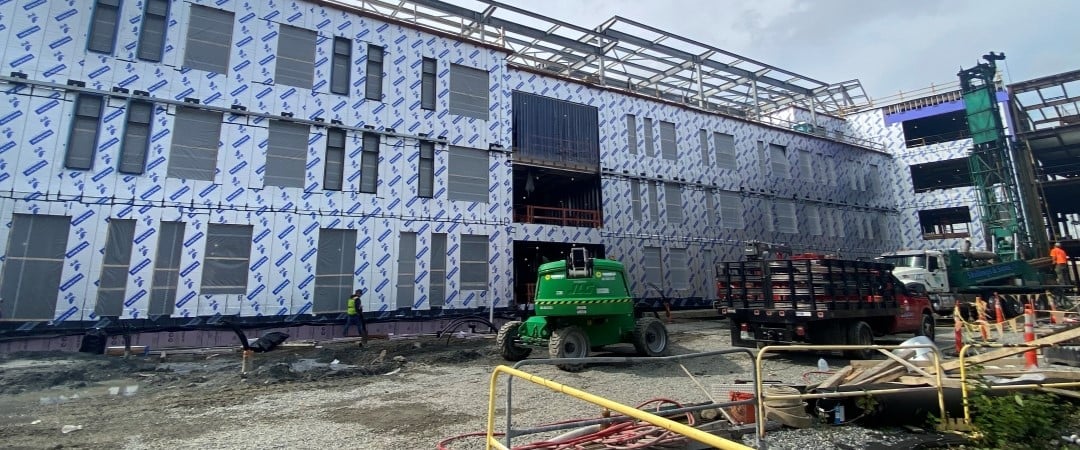The Best Weather-Resistant Barrier for Building Construction
12 minutes read

Beware: The term “-resistant” does not = “-proof.”
Selecting the right weather-resistant barrier (WRB) ensures the long-term durability and energy efficiency of a building. The best WRBs not only protect structures from water intrusion and moisture damage, but also contribute to thermal insulation and air sealing.
That doesn’t mean “weather-resistant” and “commercial construction” are an obvious match. In reality, many WRBs are common in house construction and can’t truly perform as weatherproofing products to the level a commercial subcontractor needs.
Learn below which product types are water-resistant and which are waterproof, then see what matches up best with your protection needs.
What Is a Weather-Resistant Barrier (WRB)?
A WRB plays a critical role in protecting the building envelope from water and air infiltration while allowing moisture to escape, preventing damage and mold growth. The best weather-resistant barriers of today improve energy efficiency and maximize comfort for those who live or work in the building.
Is an Weather-Resistant Barrier an Air Barrier?Yes and no. Air and vapor barriers have different levels and areas of functionality than a WRB. An air barrier reduces the flow of air through the structure’s exterior walls, while the vapor barrier reduces the flow of water vapor. An air barrier can double as a weather-resistant barrier, but not the other way around. An air barrier takes protection a step further. A water-resistant barrier reduces the flow of liquid water, but doesn’t facilitate the escape of moisture from within. |
WRBs come in various forms, including building wraps, self-adhering membranes, fluid-applied membranes, and board stock. Each type has its own advantages and methods of application:
|
Building |
Self-Adhering Membrane |
Fluid-Applied Membrane |
Board |
|
|
Material |
Synthetic fabrics or fibers |
Rubberized asphalt, polymers |
Polymer-modified asphalts, acrylics |
Fiberglass-faced gypsum, foam insulation |
|
Main Use |
General wall assembly |
High moisture areas, detail work |
Seamless barrier over entire surface |
Sheathing & WRB in one, rigid support |
|
Permeable? |
Very |
Variable |
Variable |
Not very |
|
Installation |
Mechanically fastened |
Peel & stick |
Sprayed or rolled on |
Screws or nails |
|
Positives |
Cost-effective, easy to install |
Manufactured at a specific thickness |
Seamless coverage, versatile |
Structural support, moisture resistance |
|
Negatives |
Can tear, proper sealing needed |
Requires careful installation |
Labor-intensive, weather-dependent |
Less permeable, potential for moisture trap |
8 Factors in Choosing a WRB Installation
Because not all weather-resistant barriers are suitable for commercial construction, be mindful of your project parameters. Moisture protection is a necessary part of virtually any build, although certain criteria are more important based on climate or regional standards.
Here's a structured approach a commercial subcontractor can take to assess the performance level needed out of a barrier:
- Local climate conditions
- Building design and materials
- Moisture management requirements
- Compliance with building codes and standards
- Installation process
- Integration with other building envelope components
- Cost vs. performance
- Manufacturer’s reputation and warranty
1. Understand Local Climate Conditions
Climate might be the biggest influence on the choice of building envelope protection products. Different climates pose unique challenges. For instance, areas with high rainfall or humidity levels require barriers with superior water resistance and breathability.
In areas receiving more than 20” of annual precipitation, the general rule is to use drainage techniques. This is particularly important if the cladding material is absorptive (think stone, brick, and stucco).
Consider the expected life span of the building and the barrier's resistance to UV exposure, tearing, and punctures. A durable WRB can reduce maintenance costs and extend the life of the building envelope.
Trapezoidal tear tests can measure resistance to ripping. This knowledge allows you to predict the likelihood that the WRB will continue to protect the structure as it ages.
2. Analyze Building Design and Materials
The design of the building, including its orientation, architectural features, and the materials used, should influence the selection of a barrier.
Physical traits can create chemical impacts (which in turn affect those physical traits). For example, UV resistance may be a big factor in your purchase if the sun bears down on the building for long periods each day. Even simple materials like wood can leach chemicals, penetrating the WRB.
Other architectural and engineering factors that can increase moisture risks include:
- Wall assembly type
- Insulation placement
- Cladding use and type
3. Consider Moisture Management Requirements
Effective moisture management is the #1 key to securing a building envelope. Assess the building's vulnerability to moisture and the potential for condensation within wall assemblies. This assessment will help determine the level of vapor permeability required of the WRB.
Dr. Joseph Lstiburek, founding principal of Building Science Corporation, recommends a “sweet spot” of 10-20 perms for the optimal balance of moisture protection and breathability. Anything below this window will compromise the outward drying potential. Anything above makes the structure vulnerable to the moisture that is driven out of the cladding.
4. Compliance With Building Codes and Standards
Building codes and standards vary by region and can dictate specific requirements for weather-resisting barriers, such as permeability ratings and installation methods. Ensure that the chosen WRB meets or exceeds these requirements for legal compliance and optimal performance.
Codes and standards are dependent on the type of construction. For example, Type 5 generally involves wooden buildings no more than five stories. Masonry materials – such as brick, concrete blocks, and stone – can absorb water. This rolls out the (soon-to-be-moldy) red carpet for dampness, mold growth, and even structural damage to the building.
Select a WRB that’s compatible with the masonry and the overall design of the wall assembly. This includes proper integration with flashings, weep holes, and other components of the moisture management system. The goal is to ensure that any water that penetrates the veneer can drain, and that the wall assembly dries effectively to prevent moisture accumulation.
Water isn’t the only elemental threat. Fire-resistant barriers must undergo rigorous testing by accredited bodies to verify that they meet specified fire ratings and performance criteria. The testing process typically involves exposing the barrier to controlled fire and heat conditions to simulate real-world scenarios.
Code-mandated water-resistive barriers are typically limited to residential and low-rise structures.
5. Installation Process
The ease of installation for a weather barrier product is deceptively influential on project timelines and labor costs. To get a leg up, consider the WRB's:
- Compatibility with the construction process
- The skill level required for installation
- Any special equipment needed
- Ability to work with the surface type
Areas on a structure where breaks can happen, like windows, doors, and attached decks, require special attention as a potential entry point for water. You’ll need to properly apply tape and sealant on all seams and edges, and integrate the barrier with other flashings to provide the best possible protection.
Spray WRBs offer better coverage on uneven surfaces. Self-adhered WRBs are better for flat surfaces but provide a more consistent level of protection.
6. Integration With Other Building Envelope Components
A weatherproofing product must work seamlessly with other components of the building envelope, such as:
- Flashings
- Sealants and tapes
- Air barriers
Consider whether your potential WRB choice can help create a continuous shield against moisture and air.
The combination of a flashing and a WRB, for example, will create a shingled effect to direct liquid water away from the exterior. Choosing a WRB independently doesn’t optimize its functionality – teamwork does.

7. Cost vs. Performance
Cost is always a construction consideration, from heavy-duty equipment all the day down to No. 2 pencils. But it’s important to balance initial expenses with long-term benefits. A more expensive WRB that offers better protection and energy efficiency can reduce the need for repairs and lower energy costs over time.
Ultimately, it comes down to the contractor product knowledge and the property owner’s budget preferences. Is everyone looking for the top-performing option, or simply looking to save money?
8. Manufacturer's Reputation and Warranty
Research the manufacturer's reputation for quality and reliability.
A manufacturer with a long-standing history of producing high-quality, reliable building envelope products is more likely to offer solutions that have been tested and proven in a variety of climates and job sites. Look for manufacturers that are transparent about their testing procedures and compliant with industry standards such as ASTM or ISO. You can also refer to:
- Product reviews
- Case studies
- A distributor with technical product expertise
A comprehensive warranty is not just a promise of repair or replacement. It can also provide assurance of a building weather barrier’s performance and durability.
An effective warranty should cover not only the material, but also potential defects in performance over a reasonable period. It's important to understand the warranty's scope, including any conditions or maintenance routines necessary to keep it valid.
The Best Weather-Resistant Barrier Might Not Come Cheap
Selecting the best weather-resistant barrier ensures:
- Compatibility with cladding
- Ease of installation
- Safe management of bulk water and vapor permeability
By keeping water out and improving insulation, a high-quality exterior-building product contributes to a secure, comfortable indoor environment. Speaking of environment, it also promotes energy savings throughout the building's life.
Don’t get caught up in cheap products that don’t mesh with your commercial-grade goals. Weather-resistive barriers – or air barriers – are a choice that sets the foundation for a healthier building. By carefully considering the eight factors outlined above, commercial subcontractors can get it right the first time, every time.

